Food for the Soul: Good Versus Evil in Art

The belief in a supernatural source of evil is not necessary; men alone are quite capable of every wickedness.” ~ Joseph Conrad, Under Western Eyes (1911)
By Nina Heyn – Your Culture Scout
The struggle between the forces of good and evil lies at the root of all religions. In India, one of the most important Hindu religious celebrations of the year is Diwali, which symbolizes the spiritual “victory of light over darkness, good over evil, and knowledge over ignorance.” On the third day of this festival, homes are lit with thousands of lights, and the streets fill with celebrations devoted to the goddess Lakshmi.

In later religions, the role of a divine protector of humans has been assigned to Archangel Michael. He is believed to be the force of good not only in all forms of Christianity but also in Islam (as Mikail, the archangel of mercy) and Judaism (as a defender of the Israel tribes). In all these religions, a human need to believe in a merciful defender has overcome any attempts by theological purists to dispense with this divine protector. Naturally, such a powerful personification of good overcoming evil has found its way into art. From about 4th century AD, when Archangel Michael started being widely venerated, there have been images of this sword-armed angel stomping over a writhing devil.
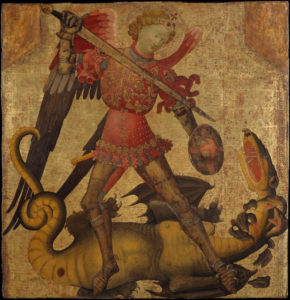
In medieval and early Renaissance iconography, the archangel is a knight, fully clad in shining armor, a supernatural version of the local warrior that would lord over church worshippers in a village. His adversary is equally supernatural—a devil imagined and portrayed according to an artist’s ability.
Here is a wonderful detail from a panel by Spanish Renaissance painter Bartolomé Bermejo. The devil has scales, pointy teeth on two sets of jaws, red shining eyes (also two sets), and a large red tongue. Evil is something very concrete—easy to scare children and gullible masses.
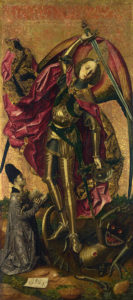
One of the most popular representations of St. Michael’s victory over the evil incarnated is a painting by Baroque artist Guido Reni. This image has been copied by artists and rendered in folk and commercial illustrations for centuries. The original is still in the Roman church of Santa Maria della Concezione dei Capucini, for which it was commissioned in the early 17th century. There is a story that the face of the Satan here resembles the features of the Roman Cardinal Pamphili (later to become Pope Innocent X), an opponent of Reni’s patrons. Reni had a persecution mania, and he felt that the Cardinal had slighted him, so he took his revenge in the artistic form. Regardless, it is interesting to see that Satan in this picture is no longer a medieval dragon, not even a classic Satan with horns and membrane wings as painted about a century earlier by Raphael. By Reni’s time, Satan is very human. “Hell is other people,” as Jean-Paul Sartre noticed in No Exit.

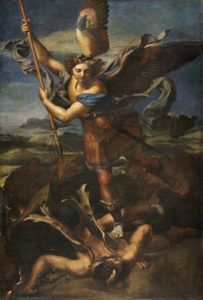
One of the most popular meeting areas in Paris for tourists visiting the Sainte-Chapelle and for students from the nearby Sorbonne University is a large and dramatic St. Michael’s Fountain. Both a landmark and a favorite meeting point, this structure was created during Haussmann’s remodel of the city in the mid-19th century, decorating a wide boulevard opening toward the river. Again, this Satan face is very human—by the 19th century, there was no doubt that evil is best personified by a fellow man.
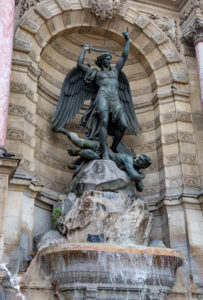
In the last two hundred years, angels and devils have become less popular in artistic representations of the eternal struggle between forces of good and bad. Human conflicts—more bloodthirsty with each new war—have supplanted the religious images in paintings.
Francisco Goya’s painting from 1814 entitled The Third of May 1808, one of the most famous masterpieces of Spanish Romanticism, is a perfect illustration of the conflict that is now entirely left to humans. The painting portrays brutal reprisals of the French army against Spanish freedom fighters in the 1808 resistance against the Napoleonic army. This emotional and dramatic scene has become a famous example of artistic commentary on the violence of war. From the point of view of art, this canvas is venerated for its masterful juxtaposition of a white shirt and desperate gestures of the prisoners bathed in glaring light, and the impassive block of stiff bodies of the execution squad. In fact, this painting was a source of inspiration for equally famous works by Edouard Manet, such as The Execution of the Emperor Maximilian of Mexico painted in 1867, and Picasso’s Massacre in Korea painted in 1951.
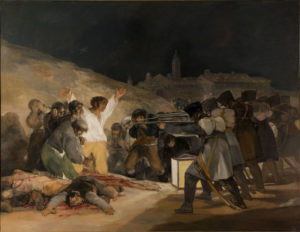
Secular paintings had to find other ways of portraying evil than a horned beast. Images of war have replaced the old-fashioned fallen angel with much scarier portrayals of brutality inflicted by men over their fellow men.

